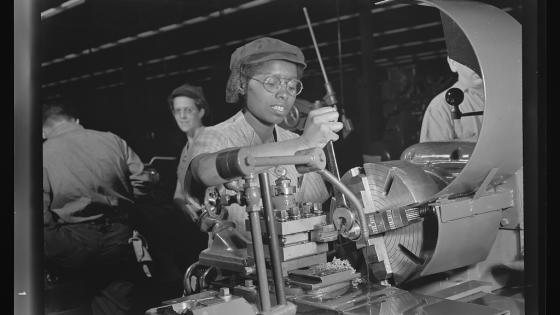Economists and policymakers have long been aware that discrimination in labour markets can create significant aggregate economic losses (Tavares and Cavalcanti 2007, Knepper and Dahl 2021). In the case of the US, labour market discrimination against women and Black workers, among other underrepresented groups, has deeply entrenched historical roots. However, sufficiently large disruptions of the labour market can challenge this status quo and lead to new equilibria with improvements for previously disadvantaged workers.
An extreme case of such disruptions is large-scale wars. For instance, more than 16 million Americans served in the military during World War II. A significant part of the prime-aged and mostly white labour force was therefore unavailable during a time when the war economy struggled to find workers. Previous research has documented how women and Black workers filled these gaps (Goldin 1991, Acemoglu et al. 2004, Aizer et al. 2020, Ferrara 2022).
The increased labour force participation among women and the significant occupational upgrading for Black men during the war persisted to some extent in the years after the conflict ended.
While this may seem intuitive, the effect of even the largest wars on the labour market outcomes of underrepresented groups is not a given. The counterexample in point is World War I, where employment and occupational gains for women and Black workers were either largely absent or evaporated quickly after the war.
In a recent paper (Ferrara 2023), I survey the literature on the labour market effects of the two World Wars on women and Black workers in the US to outline the conditions under which underrepresented groups can make persistent occupational and employment gains during periods of substantial labour shortages. The case of the US is interesting due to these wars mainly being fought abroad, thus avoiding the economic damages ordinarily associated with large-scale conflicts (Koczan and Chupilkin 2022), and hence researchers can abstract from this dimension when studying the US labour market at the time.
To guide interpretation of the empirical body of work, I first discuss how labour demand, employment, and wages of different groups are affected during wartime in a canonical constant elasticity of substitution (CES) setting, and what the predicted patterns of occupational selection should look like in a standard Roy model. Especially for the short run, these models provide helpful benchmarks on the implied elasticities of substitution for each group that one should expect to see in the data.
A simple estimation of the elasticities from the model with data from the 1910 to 1940 census files reveals that women and Black men were much closer substitutes – albeit still imperfect ones – for white men during World War II than World War I. This is not to say that there were no gains at all during World War I. From 1910 to 1920, the share of Black male workers in durable and non-durable goods manufacturing rose to 22.4% from 8.8% and to 11.9% from 4.5%, respectively. In February 1918, aircraft manufacture companies employed 169 women per 1,000 workers, rubber 55 women per 1,000 workers, and lumber companies 276 women per 1,000 workers; in six months, these figures rose to 186, 140, and 354 women per 1,000 workers, respectively (Women’s Bureau 1920).
Then why did these gains not persist as was the case after World War II? Two key reasons were the short duration of the American involvement in the war and the much less salient contribution of underrepresented groups on the battlefield. During World War I, leaders of the Black community had urged active involvement in the war to show Black Americans’ dedication to the country in the hope that this would improve their post-war socioeconomic position (Parker 2009). Given the brief duration of the war and the few Black fighting units in action, however, this hope was disappointed. Consequently, the labour market gains of Black workers gradually declined as the post-war economy had to accommodate returning veterans while struggling with the adjustment from military to civilian production. This was not helped by the brief but severe recession in 1921 either.
For women workers, the decline was even more drastic as returning veterans displaced them from their wartime jobs and marriage bars sought to drive out married women specifically. Nonetheless, some important progress was made for women outside of the labour market. For example, Arnsbarger (2023) shows that Congress members from districts with higher wartime employment among women workers were more likely to support ratification of the Nineteenth Amendment that gave women the right to vote.
The story of World War II was a different one. With 16 million Americans serving in the military (12% of the population), the wartime labour shortages were much more pronounced than during World War I when 4 million Americans served (3.8% of the population). These shortages also lasted longer in World War II – 45 months compared to 19 months in World War I. As a result, the share of married women who worked rose from 15.6% in 1940 to 21.7% in 1944 (Goldin 1991), and according to the 1950 census, this number remained steady after the war, at 23.8%. Even though women workers still experienced higher rates of job displacement due to returning veterans, especially among those with education lower than a high-school degree (Acemoglu et al. 2004), the legacy of ‘Rosie the Riveter’, a cultural icon who represented the women who worked in factories and shipyards during World War II, had made great strides towards normalising women in the workplace.
The labour gains made by Black men during the war years were also largely maintained in the following decades. The largest change was seen in the occupational distribution within this group. After being mostly stagnant in the decades prior to the war, the share of semi-skilled Black workers rose from 15% in 1940 to 45% in 1970 in the South, and from 25 to almost 50% outside the South over the same period (Ferrara 2022). Hence, this development cannot be explained by the Great Migration alone. Aside from the size and duration of the wartime labour shortages, other developments helped Black men and women workers to maintain their occupational gains. This includes the booming post-war economy but also other technological and cultural changes.
When comparing the literature on the labour market effects of the World Wars, it is striking how much more popular work on the second World War is relative to the first. Likely reasons for this are the availability of data, as well as other contemporaneous shocks which complicate studying the labour market during World War I. In particular, the first wave of the Great Migration, the growing boll weevil infestation of Southern cotton fields, the end of the Age of Mass Migration, and the influenza pandemic all occurred at the same time, meaning that these additional factors need to be accounted for.
When it comes to the data, the 1940 census was the first to record information on incomes and wages. Researchers therefore have to rely on occupational income scores as imputed measures of income in earlier years. The key data advantage that the period surrounding World War I holds is that the full count censuses with individual’s names are available, opening the opportunity to link workers over time. However, this advantage will evaporate as soon as the 1950 full-count census is released. The current trend in the preference for studying World War II will therefore likely continue in the future.
References
Acemoglu, D, D Autor, and D Lyle (2004), “Women, war and wages: The effect of female labor supply on the wage structure at mid-century”, Journal of Political Economy 112(3): 497–551.
Aizer, A, R Boone, A Lleras-Muney, and J Vogel (2020), “Discrimination and racial disparities in labor market outcomes: Evidence from WWII”, NBER Working Paper 27689.
Arnsbarger, M (2023), “The political economy of women’s suffrage and World War I”, mimeo.
Bose, G, T Jain, and S Walker (2022), “Women’s labor force participation and household technology adoption”, European Economic Review 147(104181): 1–14.
Ferrara, A (2022), “World War II and black economic progress”, Journal of Labor Economics 40(4): 1053–91.
Ferrara, A (2023), “Wars and the labor market outcomes of minorities in the US”, NBER Working Paper 31811.
Goldin, C (1991), “The role of World War II in the rise of women’s employment”, American Economic Review 96(2): 741–56.
Knepper, M, and G Dahl (2021), “Economic recessions and age discrimination”, VoxEU.org, 13 April.
Koczan, Z, and M Chupilkin (2022), “The economic consequences of war”, VoxEU.org, 14 December.
Parker, C (2009), Fighting for democracy: Black veterans and the struggle against white supremacy in the postwar South, Princeton NJ: Princeton University Press.
Tavares, J, and T Cavalcanti (2007), “Gender discrimination lowers output per capita (a lot)”, VoxEU.org, 16 October.



